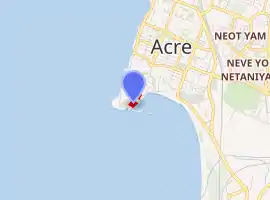Khan al-Umdan
Khan al-Umdan (Arabic: خان العمدان: "Caravanserai of the Pillars" or "Inn of the Columns", also known as Khán-i-ʻAvámid) is the largest and best preserved caravanserai in Israel.[1][2] Located in the Old City of Acre, it is one of the prominent projects constructed during the rule of Ahmed Jezzar Pasha in Galilee, under the Ottoman era.
| Khan al-Umdan | |
|---|---|
خان العمدان | |
 | |

| |
| Alternative names | Hebrew: ח'אן אל עומדאן Baháʼí name: Khán-i-'Avámid |
| General information | |
| Type | Caravanserai |
| Architectural style | Ottoman |
| Location | Acre, Israel |
| Completed | 1784 |
| Technical details | |
| Floor count | 2 |
| References | |
| archnet.org | |
History
Ottoman period
Being one of four Khans in Acre, Khan al-Umdan was built in 1784 on the place of the Royal Customs house of the Kingdom of Jerusalem. Due to its plethora of columns the khan was named Khan al-Umdan which means "Inn of the Columns" or "Caravanserai of Pillars".[1][2] It incorporates forty columns made of granite that were taken from Caesarea, Atlit and the ruins of Crusader monuments in Acre itself.[1]
_-_Han_El_Umdan_clock_tower.jpg.webp)
Due to its proximity to the port, Khan al-Umdan has throughout its history been an important trading spot. Merchants arriving at Acre used the khan as a warehouse while the second floor functioned as a hostel.[3][4] Camel caravans once brought produce and grain from Galilean villages to the city's markets and port.[5]
The khan later gained importance to the Baháʼí Faith (as the Khán-i-'Avámid) as it was the site where Baha'ullah used to receive guests, and later the site for a Baháʼí school.
In 1906 a clock tower was added adjacent to the main entrance to the khan to commemorate the silver jubilee of the rule of Ottoman sultan Abd al-Hamid II. It is similar to the Jaffa Clock Tower, a building dedicated to the same purpose, [1] along with five more towers in Ottoman Palestine (in Jerusalem, Haifa, Safed, Nablus, and possibly Nazareth) and over a hundred across the entire empire.
Modern era
In 2001 Khan al-Umdan, together with the rest of Acre's old city, was designated as a world heritage site.[6] In 2004 Khan al-Umdan (Hebrew: ח'אן אל עומדאן) was featured on a stamp of Israel worth 1.3 sheqels.[7] Nowadays, the khan is a major tourist attraction open all hours of the day and used as an open-air stage during festivals in the city, such as the theater festival of Acre during the month of October.[8]
References
- "Umdan Khan". archnet.org. Archived from the original on 2011-08-05. Retrieved 2009-01-29.
- Vilnay, 1963.
- "Khan el Umdan". Eye on Israel. Archived from the original on 2011-07-19. Retrieved 2009-01-29.
- "DSCN0594". Steve Slepchik. Retrieved 2009-01-30.
- Dumper and Stanley, 2006, p. 7.
- "Old City of Acre". UNESCO World Heritage Centre. Retrieved 2009-01-29.
- "The Acre Clock Tower, Khan El-Umdan". boeliem.com. Archived from the original on 2017-12-01. Retrieved 2011-09-06.
- "Inn Of The Pillars". TrekEarth. Retrieved 2009-01-29.
Bibliography
| Wikimedia Commons has media related to Khan al-Umdan. |
- Dumper, Michael; Stanley, Bruce E. (2006). Cities of the Middle East and North Africa: a historical encyclopedia (Illustrated ed.). ABC-CLIO. ISBN 9781576079195.
- Vilnay, Zev (1963). The Holy Land in old prints and maps (2nd ed.). R. Mass.